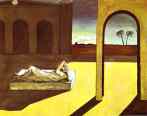Giorgio de Chirico Biography
Giorgio de Chirico was born in Greece into the family of an Italian railroad engineer and later studied in Athens, Florence and Munich, where he was much influenced by Nietzsche's philosophy and Arnold Böcklin's Symbolist art. In 1910, de Chirico moved to Paris where he made contact with Picasso and befriended Guillaume Apollinaire (1880-1918), French poet and leader of the avant-gardistic movement rejecting poetic traditions in outlook, rhythm, and language. In Paris he began to produce highly troubling dreamlike pictures of deserted cities, eg. The Great Tower, The Soothsayer's Recompense, Mystery and Melancholy of a Street, etc.; pictures with fantastic combinations of images that carried a charge of mystery, eg. Love Song, Portrait prémonitoire de Guillaume Apollinaire, The Uncertainty of the Poet, et al. The same haunting shapes tend to appear again and again in poetic combinations.
In 1917 in the Ferrara military hospital, de Chirico met a compatriot, also a painter, Carlo Carrà (1881-1966), and together they founded Metaphysical painting. Although the movement was short-lived, it was perhaps the most original and important movement in the Italian art of the 20th century, and the highest point in de Chirico's painting career. De Chirico's Metaphysical paintings were hugely influential on Surrealist artists, who recognized in them the eloquent expression of the unconscious and nonsensical to which they themselves aspired. "In words and by example, Ernst, Tanguy, Magritte, and Dali, among others, showed a rare unity in acknowledging de Chirico as a forerunner master." (p. 165 in Modern Art. By Sam Hunter et al. Harry N.Abrams, Inc. 2000) In 1918 de Chirico and Carrà contributed to the periodical Valori Plastici which gave a literary aspect to Metaphysical painting.
By the 1930s, however, de Chirico had moved to a more conventional form of expression. His great interest in archeology and history took the form of Neo-Baroque paintings full of horses, still-lifes, and portraits. The Surrealists, in particular, condemned his later work.
In 1929 de Chirico wrote Hebdomeros, a dream novel; but in the 1930s, after he had returned to Italy, he renounced all his previous work and reverted to an academic style, and to his study of the techniques of the old masters. He published his autobiography Memorie della mia vita in 1945.
Bibliography
Chambers Biographical Dictionary. Chambers. 1996.
Painting of Europe. XIII-XX centuries. Encyclopedic Dictionary. Iskusstvo. 1999.
Modern Art. By Sam Hunter et al. Harry N.Abrams, Inc. 2000
The Memoirs of Giorgio De Chirico by Giorgio De Chirico, Margaret Crosland (Designer). DaCapo Press, 1994.
Giorgio De Chirico: The Endless Voyage (Pegasus) by Wieland Schmied. Prestel USA, 2002.
Giorgio De Chirico and America by Emily Braun (Editor), Giorgio De Chirico. Umberto Allemandi, 1997.
De Chirico and the Mediterranean by Giorgio De Chirico (Illustrator), Jole De Sanna (Editor), Carlo Teha. Rizzoli International Publications, 1998.
Enigma of Giorgio de Chirico by Margaret Crosland. Dufour Editions, 2000.
De Chirico: The Metaphysical Period, 1888-1919 by Paolo Baldacci, Jeffrey Jennings (Translator), Giorgio De Chirico. Bulfinch Press;, 1998.
- The Great Tower./La Grande Tour.

1913. Oil on canvas. 123.5 x 52.5 cm. Kunstsammlung Nordrhein-Westfalen, Düsseldorf, Germany.
- The Soothsayer's Recompense.

1913. Oil on canvas. The Philadelphia Museum of Art, Philadelphia, PA, USA.